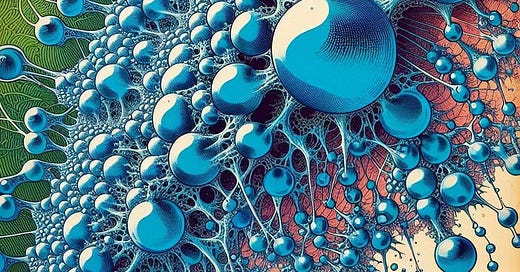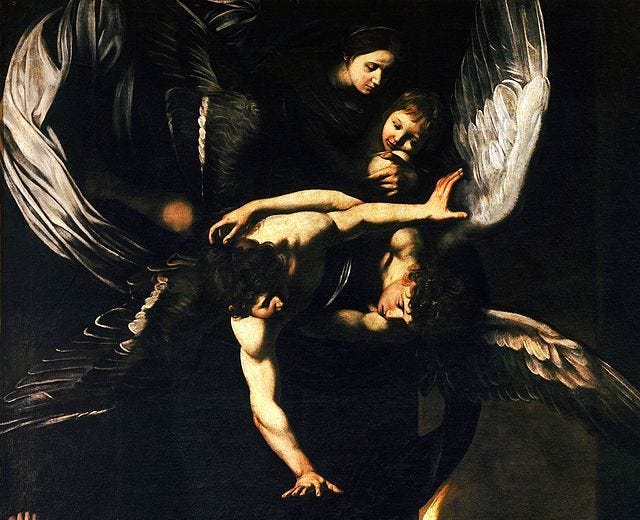The Pan-Indo-European Root *Sam Denotes the Concept of Togetherness
Van Der Waals Forces in Physics translated into Sanskrit
Dewdrop on a Leaf — Image by Author
As an enthusiast seeking to bridge science and spirituality, I’m eager to learn from experts in both realms. My mindset drives me to ponder the parallels between physics and metaphysics. I enjoy synthesizing scattered fragments that spark my curiosity.
This tendency led me recently to notice a few basic similarities between Van der Waals forces in chemistry and ideas from Vedanta philosophy.
Let me humbly share this novice analogy I pondered between these unlikely domains. I offer it as a conversation starter, hoping to learn from others with greater wisdom in these profound matters.
Cover Image
I created this cover image to visually evoke the central idea of the article — the existence of hidden connections linking all things together. It shows drops of water, arranged side by side, bound by a web of connections.
I chose water as the element that best represents the notion of an invisible but omnipresent bond, just as Van der Waals forces hold molecules together in liquids. The image aims to convey, through a simple visual metaphor, that even the smallest and most fragile things can have surprising effects when organized into a network — just as explained in the article regarding the barely perceptible forces that nonetheless determine the behaviour of matter.
Cartoon-style
I opted for a plain, almost cartoon-style graphic to translate the abstract concepts into an easily grasped vision. By paring down the details, I hoped to spotlight the essence behind the ideas — that everything is united in an intricate infrastructure of subtle links. Just as the power of comics often lies in symbolism more than realism.
Van der Waals forces
Van der Waals forces are tiny attractions between molecules that help hold substances together. They are named after Johannes van der Waals, a Dutch scientist who first proposed their existence in 1873. These forces happen because of small imbalances in the charge distribution around molecules.
Molecules are always moving around and their electrons are shifting positions. This can make one part of a molecule slightly positive and another part slightly negative for a brief moment. The positive and negative sections then attract each other like weak magnets.
So van der Waals forces are temporary tiny electrical attractions that take place when molecules get very close to each other. The attractions are weak compared to chemical bonds.
Molecules
However, they are important because they help stick molecules together in liquids and solids. Without van der Waals forces, substances like water would turn into gas at much lower temperatures. The van der Waals forces between molecules provide important sticking power that keeps them joined together.
Although remarkably feeble compared to chemical bonds, Van der Waals attractions critically determine the behaviour of gases, liquids, and solids at both microscopic and macroscopic scales. For example, these basic sticking forces drive the condensation of water vapour into liquid dew drops.
As a batch of air cools down at night, Van der Waals attractions lure water molecules floating randomly in the gaseous state to huddle closer together. At first, the molecules just swarm in a more concentrated way, while still keeping their freedom of motion as a gas. But progressive cooling gradually overpowers the molecular motion until the tiny Van der Waals forces coax the water molecules into coordinated arrangements that make up tiny liquid droplets — minuscule beadlets of dew suspended within the humid night air.
Sajānasaṅgati
Such cooperative emergence resembles the principles of the Sanskrit term Sajānasaṅgati. This concept refers to associating with virtuous or good people. It is often mentioned in Vedanta philosophy, suggesting that spending time with good individuals can be beneficial for one’s personal and spiritual growth.
Vedanta philosophy describes existence as a diversified manifestation of Brahman, an ultimate reality that goes beyond yet exists within everything as their basic essence. Van der Waals bonds, sticking together the varied phenomena of nature, demonstrate at a microscopic scale the unifying power of Brahman.
Connections
Though individually negligible, vast networks of van der Waals connections structurally link the fabric of creation in latticeworks of intricate order — thereby creating coherence from multiplicity.
I see a profound embodied analogy between Vedanta ideas and van der Waals coupled systems. Vedanta analogizes existence to a web of mutual interdependence, where everything is intricately connected. In molecular systems, minute van der Waals couplings work together to alter the overall material properties.
Forces
Just as the barely noticeable Van der Waals forces collectively change the shape and behaviour of matter, Vedanta sees reality arising from the subtle interplay of all things. No part stands alone, just as Van der Waals couples are not isolated. Their cooperative action modifies the whole system.
Appreciating this interrelation, we better recognize how subtle connections once dismissed as negligible can have pivotal impacts when aggregated in larger wholes. Therein emerges a microcosmic insight into the power attained through Sajānasaṅgati, as the wise company helps seekers transcend the limits of solitary practice. Through integrated action, combinations exceed the sums of their parts — expressing the multiplicative power of unification.
An Ancient Neapolitan Proverb Enfolds an Upanishadic Truth
The Seven Works of Mercy — Caravaggio (Pio Monte della Misericordia — Naples) — WikiCommons Image — https://upload.wikimedia.org/wikipedia/commons/thumb/a/a9/Sette_opere_di_Misericordia_-_Madonna_col_Bambino_e_angeli.jpg/640px-Sette_opere_di_Misericordia_-_Madonna_col_Bambino_e_angeli.jpg
Adi Shankaracharya
As expressed in an insightful verse by Adi Shankaracharya in the Bhagavadgita-bhāṣya, 13.8–12:
sajānasaṅgatirnityaṃ vivekavijñānāya | vivekavijñānādvairāgyaṃ dairāgyānmumukṣutvam | mumukṣutvātprabodhaḥ prabodhānmokṣaḥ ||
“The company of the good is the means to acquire discrimination between the real and the unreal; discrimination is the means to obtain detachment from sensual pleasures; detachment is the means to obtain the desire for liberation; the desire for liberation is the means to obtain self-knowledge; self-knowledge is the means to obtain liberation.”
Viveka
The essence is that spending time with spiritually developed individuals cultivates discernment and aids our inner growth. Their uplifting presence fosters Viveka — wisdom to discriminate between the eternal and illusory. This clarity engenders vairagya — dispassion towards mundane sensual pleasures, as one realizes their fleeting nature. The detachment then evokes an intense longing for spiritual liberation. That yearning leads to self-knowledge of one’s divine essence. At last, such awakened awareness of the Self confers moksha — emancipation from ignorance and suffering.
The company of sages
Thus Sajānasaṅgati, according to Vedanta, catalyzes an inner evolution from confusion to clarity, attachment to detachment, and illusion to realization. The company of sages or friends or personal in general thirsty for knowledge, truth and spirituality provides inspiration, wisdom and subtle elevating energies that awaken our highest potential. Their exemplary lives teach us how to live more consciously. Their presence exudes an atmosphere of selfless love that softens egotism and uplifts consciousness. Associating with such highly evolved beings advances us along the spiral path from worldly bondage to spiritual liberation.
Conceptual parallels
Etymological examination reveals interesting conceptual parallels between Van der Waals forces and spiritual ideas like Sajānasaṅgati.
The pan-Indo-European root *Sam denotes concepts of oneness, wholeness and togetherness. From this origin sprang Sanskrit terminology conveying synthesis and unification: sajānasaṅgati (“fellowship of virtuous people”), samiti (“assembly”), samavāya (“inherence”), samādhi (“concentration”), saṃsarga (“union”), samparka (“contact”), samvedana (“interaction”), samghaṭa (“being united”) and sambandha (“relation”).
In this vein, I think saṃbandha-bhautika-shakti could be a very beautiful and poetic Sanskrit translation of Van der Waals forces. The term “saṃbandha” means “relation” or “connection”, the term “bhautika” means “physical”, and the term “shakti” means “force”.
So, saṃbandha-bhautika-shakti means “physical connecting force”.
Conclusions and Takeaways
The speech of Van der Waals for his Nobel Prize pronounced on December 12, 1910, demonstrates how his equation made it possible to explain phenomena like the liquefaction of gases, surface tension, capillarity, and molecular cohesion, thanks to the introduction of attractive forces between molecules, which are named after him.
Van der Waals concludes his speech by stating that his work has contributed to “make clearer the vision of the continuity of nature”, that is the conception that all physical phenomena “are tied” by universal and harmonious laws.
Please share your reflections, questions, or personal experiences in the comments below.
I have woven tales to share, for any who care to read them. My books await you on Google Books. Check also my stories on Medium.com.
I would be honoured if you considered subscribing to the Premium Contents of my Vedanta Substack and leaving feedback, comments, and suggestions both on this page and by writing to me at cosmicdancerpodcast@gmail.com.
Thank you for reading.





